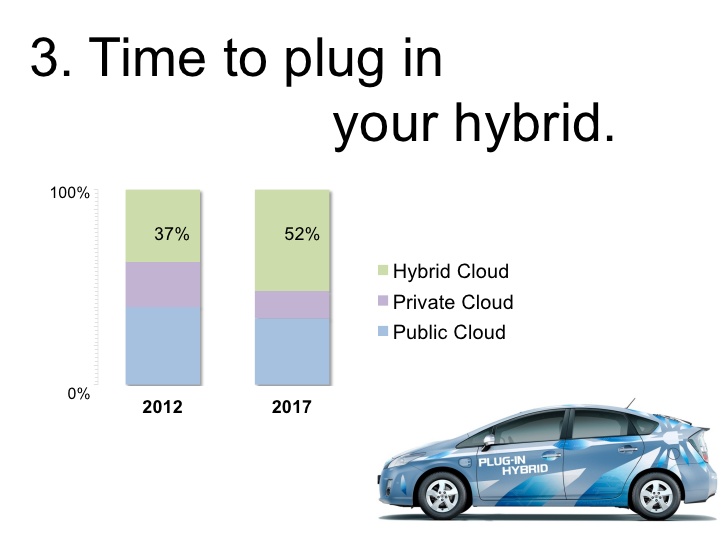Skim any cloud computing survey done in the past year or so, and there’s a good chance you’ll find glowing predictions for the hybrid cloud. Scan the landscape for actual usage of these mixed public and private clouds by real-world enterprises, however, and you may come away with a different picture.

Why the disconnect?
“It seems very attractive to use a hybrid cloud, but existing enterprise applications are not designed to run in multiple places, and the interdependencies are sometimes unknown by the business,” David Butler, senior vice president of marketing at Eucalyptus, told Linux.com.
It’s certainly not that hybrid cloud environments don’t offer myriad benefits; that they clearly do. Rather, a number of factors are just now beginning to fall into place that will propel their adoption, according to several experts.
Hybrid Cloud Adoption to Grow
Optimistic data about the hybrid cloud abounds. A few cases in point:
* In a survey released back in February, Frontier Technology and Vision Solutions found that “hybrid models are the most popular choice for companies looking at how they can make the most of cloud computing for their business needs.”
* Recent data (PDF) from IDG Enterprise predicts a considerable jump in adoption of hybrid clouds over the next 18 months.
* RightScale’s recent survey, released in June, found that 53 percent of respondents were pursuing a hybrid cloud strategy.
* Also from June, a North Bridge Venture Partners study predicted that “within five years, hybrid clouds will be the emphasis of 52 percent of respondents’ cloud strategies.”
The Best of Public and Private Clouds
There are also clearly many potential benefits to using a hybrid cloud. Flexibility, portability, choice and the ability to pay only for what you need, for example, are foremost among those benefits, said Michael Hubbard, senior director of VMware’s Accelerate Advisory Services.
So, too, is the ability to “align application SLAs [service-level agreements] to the proper virtual data center, which may or may not sit inside your four walls,” Hubbard explained.
Indeed, “there’s a whole lot of complexity associated with building your own internal private cloud,” noted Brett Goodwin, vice president of marketing with cloud computing provider Skytap. “A lot of the technology is still fairly young and evolving quickly.”
As for public clouds, “they’re great for applications where you want people to be able to access it over the internet,” Goodwin added. “But even in multitenant environments, there can be accessibility or security concerns.”
The hybrid cloud, on the other hand, “really gives you the best of both worlds: the elasticity, scalability and agility that the public cloud brings, but also the control, visibility and security that the private cloud offers,” he said.
Hybrid Clouds Not Well Understood
So why aren’t hybrid clouds more commonplace in enterprises today?
“Part of the challenge is terminology,” Skytap’s Goodwin suggested. “People understand what a private cloud is, and what a public cloud is,” but hybrid clouds are perhaps less easily understood.
Nevertheless, “we believe the hybrid cloud is really where we’re going to see enterprises benefit from cloud computing in a big way,” he added.
In order for that to happen, a number of things will need to fall into place, experts suggest.
5 Areas of Hybrid Cloud that Need Work
1. Visibility and Control
The early generation of cloud services did a good job of empowering users, Goodwin said: “They really nailed self-service.”
What was missing for enterprises, however, is “the visibility and control that IT in particular needs to manage that hybrid cloud resource as effectively as they manage on-premise resources,” he noted.
What’s needed, for instance, is “the ability for IT to set quotas, or limits, in terms of how much resources can be consumed,” Goodwin said, as well as features such as automated notifications and reporting.
2. Security
Security, not surprisingly, is another issue.
“I think security is a No. 1 concern that is difficult to prove,” said Butler of Eucalyptus. “Public cloud providers need to work closely with an on-premise IaaS provider to demonstrate the solution that works and provides security and best practices around operational functions.”
Ultimately, there needs to be a common toolset across the public and on-premise clouds that “just works,” Butler added. “The API wars have started, but at the end of the day, the speed and agility a business needs are truly based on getting an application running quickly and cost-effectively.”
3. Integration
Integration challenges also need to be addressed, noted Lori MacVittie, senior technical marketing manager with F5 Networks and a member of the Steering Committee for the CloudNOW consortium of women in cloud computing.
“Currently, challenges exist with integrating and normalizing network connectivity, integrating and managing cloud-based resources with datacenter hosted resources and systems, and integrating processes that control access to and delivery of applications from cloud computing environments in a way that’s consistent with business and operational policies,” MacVittie explained.
“These challenges are being addressed in a variety of ways, from software-defined networking (SDN) and network overlay protocols like VXLAN and NVGRE at the network layer to new solutions such as cloud gateways and brokers that address issues at the resource and process layers,” she added.
4. Data Synchronization
Then, too, there’s the need for synchronization of data between the datacenter and the public cloud provider, Butler pointed out.
“Standardization around the container of the application and data” is key, Butler explained. “This could include SLA, security, owners, backup/DR, etc. Just because the application moves does not mean we are not concerned with these things.”
5. Licensing and Support
Last but not least, “licensing of the OS and application that runs in two places will make the ROI/TCO easier to figure out,” Butler said. “Support also needs to be worked out. If the application runs on a cloud, will the ISV [independent software vendor] support it?”


